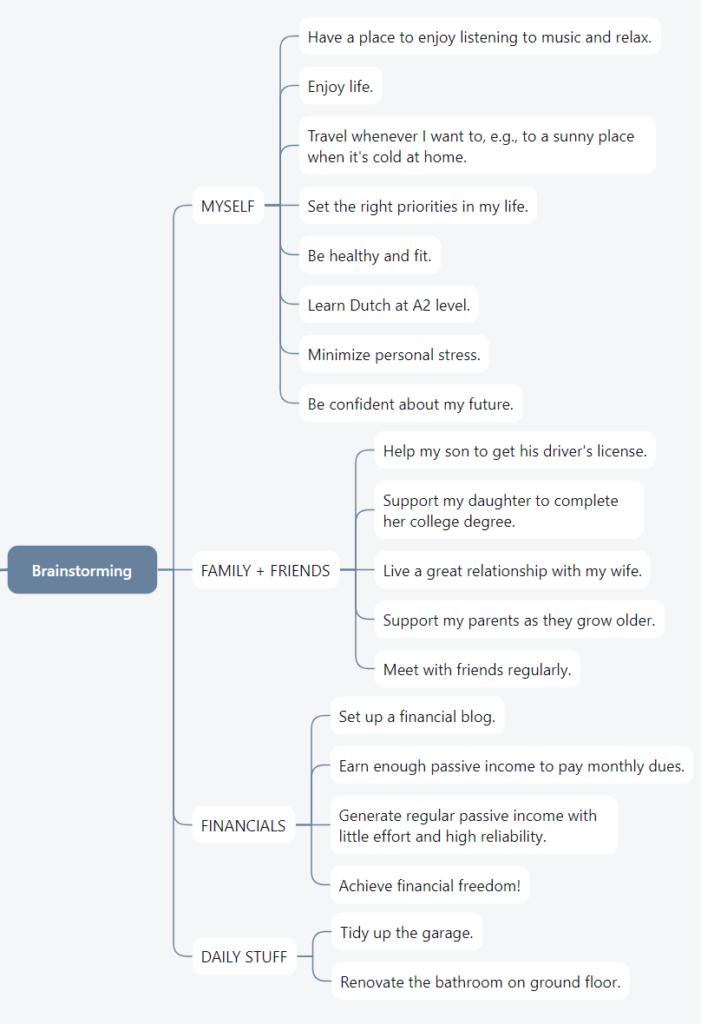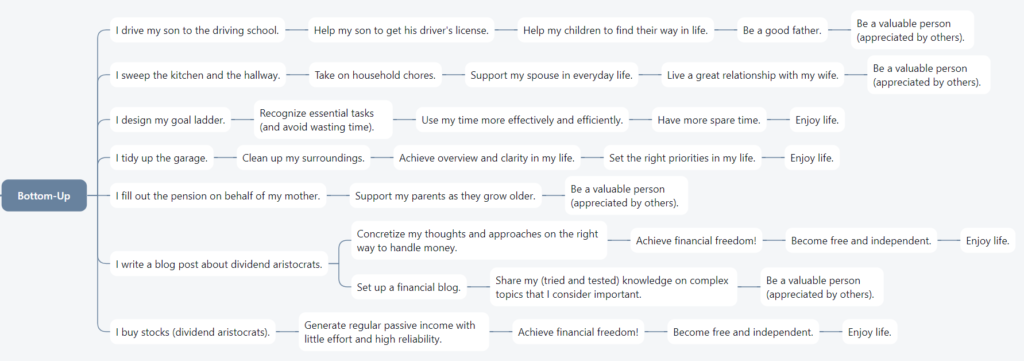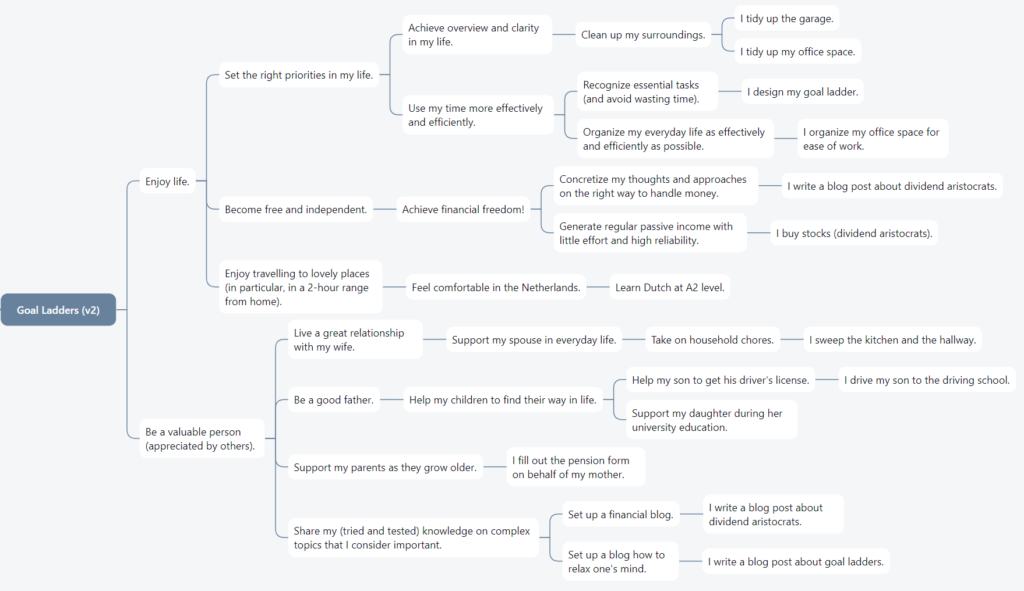We have more than enough to do these days. It’s practically impossible to keep up with all the things that need to be done to please everyone. So much to do, so little time. We need to set priorities to separate the time-wasters and nice-to-haves from the real stuff. That’s why we need clear goals so we can set bold priorities.
The Goal Trees
The goal trees collect goals and put them into tree structures. The most general goal becomes the top, and the more specific goals and objectives build down from there. Eventually at the bottom, there are small and specific objectives that may be achieved in hours or days rather than years. Usually, you will have more than one goal tree but rarely more than a few. In my case, I ended up with just three of them.
The goal trees clearly indicate what is important to you. And down the tree structure, they also figure out what the goals are actually made of. With your goal trees, you can easily make informed decisions about which task activities contribute and which do not.
Benefits
1. Get rid of useless burdens
The next time you have too much work to do, take a minute and match the tasks and duties to your goal trees. Identify which tasks contribute little or nothing at all to your goals and consider postponing, doing them short and sweet or even dropping them. The only exception is the annual tax declaration which still must be done to keep you out of trouble.
2. Regain your time and effort
Setting priorities according to your goals allows you to reduce time and effort on tasks that contribute little or nothing at all. In other words, you create spare time and effort that you can spend on meaningful stuff. Even hobbies will provide a better return-on-time-and-effort than just killing time on useless activities.
How to build your Goal Trees
The goal tree consists of goals that make up a tree. Hence, you simply collect all your goals and arrange them in a hierarchical structure. There are two straightforward approaches to do that. Consider to try both to find which works for you.
1. Brainstorm
In the first approach, start with brainstorming. Set a time limit of 10 minutes and write down any goal you can think of. During the brainstorming phase, quantity matters. Hence do not assess or reflect your thoughts. Is the goal stupid, over the top, fancy or vague? Don’t care and just put it down.
When you’re done, it’s time to bring meaning and structure to the chaos. Start with a single category called “Maybe”. Then look at each item you wrote down during the brainstorming.
- If it does not appear meaningful or relevant to you any longer, then move it to the “Maybe” category. If you are unsure, then move it there anyway. It’s not lost, and you can retrieve it later at any time if you change your mind.
- If it’s close, similar, or related to another goal, then think about a superordinate, more general goal that could enclose these goals that seem to be similar. And put the others below it as more specific subgoals.
Now you have a forest of goals that has some quite generic top goals and lots of more detailed goals below them. Set a time limit of 10 minutes and consider the result. Are there are some goals, relations or structures that bother you? Then add, rearrange, or carefully delete items to improve your goal trees. You could also put items to “Maybe” or retrieve others from there.
An alternative could be to use categories for goals that are somehow related or belong to a common group rather than trying to create a forest. I found grouping the brainstormed goals much easier than being forced to build a forest.
2. Bottom-up
The second approach is probably more straightforward, but it does not collect creative inspirations as the previous approach did.
- Start with some measures and tasks that you are currently doing or should be doing. It’s about your real life rather than what you would like to be. Collect about 5…10 tasks.
- Now it’s time for analysis. For each task, ask yourself why you do it. What is the goal that would benefit from completing the task? Write it down and relate it to the task.
- Next, look at the goal. Why do you pursue this goal? What is the superordinate goal that makes the goal at hand relevant and drives you to work on it? Again, write it down.
- Repeat the previous step unless a goal becomes so general that you can’t think of another superordinate one. Typically, this creates a hierarchy of 3…6 levels, and the most general goal would be something like “I want to take care of my family” or “I want to enjoy my life”.
Since the top-level goals are quite general, expect them to appear more than once. This just indicates that some detailed goals work towards the same superordinate goal which is perfectly fine.
Reconciliation
If you tried both approaches above, then now is the time to bring the results together. You could, for example, start with the goal trees created with the 2nd approach, and add the items collected in the 1st approach. They may fit at any level in the goal trees and could even create a new tree that did not emerge from the bottom-up approach so far.
Having done all that, have a final look at the result. These are your personal goals, beautifully structured from top to bottom, from the most general goal to quite specific objectives and actions. You’ve done it!
Examples
Let us look at examples for both approaches from my own experience. Here they are.
Brainstorming example
I followed the procedure described above and collected goals that just came to my mind. Next, I grouped them into categories. However, I found it almost impossible to create a hierarchical tree structure. Nevertheless, here is the result.

Bottom-up example
This approach starts with my ongoing activities and identifies superordinate goals unless I could not think of a more generic one. Here is my result for the bottom-up approach.

On the far right, you can clearly see that the top goals are just two that appear over and again. Now let me create a tree structure by just inverting the order of items. The result looks like this.

Reconciliation example
The result from the bottom-up approach was quite fine. However, a quick look at the brainstorming result reveals that there are some different items not mentioned in the goal trees yet. Obviously, it’s time to reconcile. Note that the example below does not yet cover all the items from the brainstorming phase. It seems I need to rework reconcile again later when I’m more familiar with the concept of goal trees. Anyway, here is the result after reconciling.

My point of view
Let’s be honest. I had a hard time with the brainstorming approach. There were many goals that came to mind, but I found it almost impossible to create a tree structure from these items. After doing the exercise, it seemed like a waste of time at first.
Thus, I considered the bottom-up approach much more effective. It still took me some mental effort to find well-crafted greater goals until eventually reaching the most high-level goal, but it was straightforward and definitely created a tree structure. However, there are shortcomings.
The bottom-up approach starts with what you are currently doing. In other words, you are already working on something that contributes to a presumably relevant goal. It might contribute just a little bit, or it might solve the whole shebang. Anyway, I am already aware of the goals. Otherwise, I would not do what I do.
And that is exactly the problem. Without the brainstorming part, I would completely miss any goals that I am currently not working on. Tahe the “Learn Dutch at A2 level” item from the brainstorming part. Since I am currently not pursuing this activity, I did not come up with it in the bottom-up approach. However, reconciling the results from both approaches made me include it.
So here is my recommendation. Simply use both approaches and reconcile the results as I did here. If you are in a hurry, start with the bottom-up approach. But you might miss some of your dreams if you never do the brainstorming part.
Conclusion
The goal trees are great for figuring out what is important to you. The approaches to build it provide surprising findings that you may not be aware of yet. The goal trees will shine light on the difference between necessary work, joyful hobbies, and elaborate ways to procrastinate. Each needs time and effort but will deliver different results and contribute differently to your life.
So how are you going to spend your time and resources? Clearly understanding your goals will make it a lot easier to decide.
Where to go next
TBD
